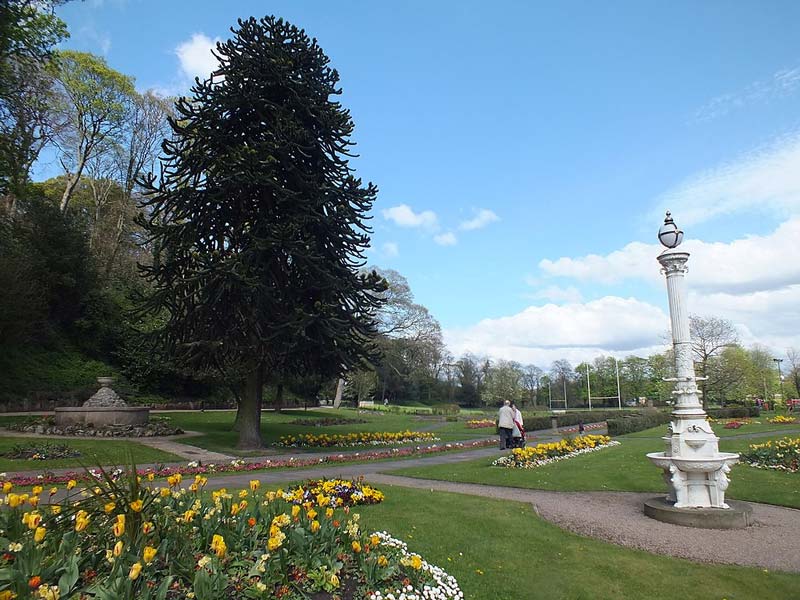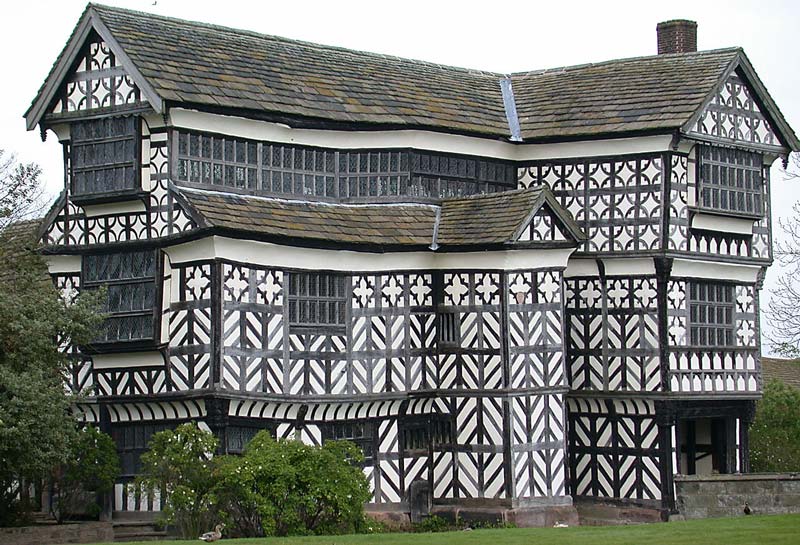Congleton is a pretty market town in Cheshire, England, offering a perfect base for walking, cycling, golf, fishing, bird watching and more in the natural beauty and landscape of this area.
About Congleton
Congleton is a small market town in England in the south-east corner of Cheshire. It is situated about 6 miles east of the M6 at junctions 17 & 18. Major Conurbations within one hour drive of Congleton are Manchester and its International Airport, Liverpool, Birmingham, Chester, Warrington, Stoke-on-Trent, Crewe and Macclesfield.
It is also within easy reach of the Cheshire Plain, Peak District, Lake District and the Welsh mountains and coast.
Attractions
Some attractions in the Congleton area include:
- If it is cycling or walking you are looking for or other outdoor pursuits such as golf, fishing and bird watching, then the natural beauty and landscape of the Congleton area can provide the perfect backdrop.
- Little Moreton Hall, pictured above (National Trust) the most outstanding timber framed moated house in Britain. Scenes from Granada TV’s “Moll Flanders” (1996) and Paramount’s “Lady Jane” (1986) starring Helena Bonham Carter were filmed here.
- Jodrell Bank, the world’s largest movable radio telescope. With exhibitions and many hands on exhibits within the Science Centre, visitors are able to discover and unravel for themselves some of the scientific wonders of the Universe. Sitting beneath countless stars in the Planetarium is amazing. (pin 4)
- Gawsworth Hall – an ancient manor house wrapped in romance, intrigue and great charm.
- Lyme Park – a Tudor house that was transformed by the Venetian architect Leoni into an Italianate palace. Used as the exterior of Pemberley in BBC TV’s “Pride & Prejudice” (1996)
- Capesthorne Hall. 18th century Jacobean-style Hall set in 100 acres of picturesque Cheshire parkland is one of Cheshire’s premier historic houses.
- During the summer months a stroll through the Public Parks (including The historic Congleton Park, pictured below) will find you amazed with the floral colours and displays. All thanks to Congletons green fingered council team. Children will also love the many play areas around the borough too.
- Congleton Paddling Pool was built in the 1930s and is open in the summer months.
- Astbury Mere Country Park lies just to the south west of the town centre, on the site of a former sand quarry. The lake is used for fishing and sailing.
- The independently run 300-seat Daneside Theatre is on Park Road.
- The 400-seat Clonter Opera Theatre is based in the village of Swettenham Heath, 5 mi (8 km) north of Congleton.
- Founded in 1971, Congleton Choral Society is a mixed voice choir which regularly performs choral works at Congleton Town Hall and other venues around the town
- Congleton Museum is on Market Square in the centre of town. It was established in 2002 and is dedicated to Congleton’s industrial history. It also contains an ancient log boat and gold and silver coin hoards.
- The town also annually hosts a food and drink festival promoting locally sourced produce/cuisine and a jazz and blues festival which showcases acts from across the UK.
- In 2019, Congleton held its first annual pride event and this celebration is still going strong in 2021.
More information can be found at The Congleton Tourist Information Centre.

Above: Congleton Park by Clem Rutter CC BY 3.0, https://commons.wikimedia.org/w/index.php?curid=19324390
History
Congleton lies at the eastern edge of the Cheshire plain at the foot of the southern reaches of the Pennine Hills. Most of the town lies between two and four hundred feet above sea level, but rises gently eastwards towards the hills.
A Neolithic chambered tomb known as the Bridestones (pin 6) is the archaeological monument that ranks first in time and importance in the Congleton area. It belongs to the “megalithic culture” characterized by the practice of collective burial in stone-built chambers beneath mounds of earth and stone. It lies approximately three miles east of Congleton at a height of nine hundred feet above sea level and is the oldest megalithic structure in the whole of Cheshire.
Early Bronze Age axe hammers have been found in and around Congleton too. More significance of Bronze Age settlement though are the barrows or burial mounds of the area. Unlike the collective burials of the past, in these tombs we find single inhumations.
There is no evidence in the area of any late Bronze Age burials. What have been found though are occurrences of weapons and implements from this period. The most notable of which was a small personal hoard belonging to a hunter of warrior and consisting of two bronze spear-heads and their bronze butts and a socketed bronze axe.
During the Iron Age there is nothing that can be claimed with any certainty in the area. This too can be said of the Roman occupation.
Congleton is first found mentioned in the Domesday Book. Before the Norman Conquest Congleton was held by Earl Godwin but in 1068 it was in the possession of a lay tenant of Earl Hugh, one Bigot de Loges. Bigot was a Norman who came from Les Loges, Calvados, arr. Vire, cant. Aunay-sur-Odon, and was in all probability a member of the family of Roger Bigot, earl of Norfolk and lord of Les Loges. Bigot also held Farndon, Lea, Thornton, Mobberley, Norbury, Alderley, Siddington, Rode, Sandbach, Sutton, Wimboldsley, and Weaver. Bigot’s lands were never recognized as a barony and its subsequent history is somewhat confused. It seems that afterwards the lands formed the basis of the fee of Aldford which was created about 1130 and included the manor of Gawsworth. In the period 1136-1146 there is a reference to Hugh, son of Bigot receiving the grant of Gawsworth. In the reign of Henry II (1154- 1189) the lord of the fee was Robert de Aldford. Nothing of the fee is known then till the early thirteenth century. When the manor of Gawsworth was in the possession of Richard de Aldford who then granted it to Herbert and Lucy Orreby. Congleton was apparently part of the Aldford fee until the reign of King John.
In the subsequent years the owners of the fee were:
- Sir John de Arderne, Walkelyn Arderne, Peter Arderne, John Arderne
- Henry de Lacy Earl of Lincoln who granted the first borough charter to the burgesses of Congleton.
- Joan de Lacy. One of Joans sub-tenants at the time was John de Porta who granted his property in Buglawton and Congleton.
- Thomas of Lancaster, Gilbert Singleton, Henry (brother of Thomas of Lancaster), John de Gaunt and The Crown
As the years past, Congletons size grew, as did the diversity of its people. Its clear that the local men liked their ale though. In 1584 42 Alehouse Keepers recieved licences. This was for a population of about 1000 people. Records show that in 1595 several people were caught illegally ploughing town land at Fol Hollow, Banky Fields, Padbridge Lane and West Heath. This may suggest that people were cutting down woodlands because the population was getting to large for the land available in the town. Two areas of the town that were strictly controlled were the Town Wood and Overwestfield. It was ordered that no timber could be cut and no animals could stray there.
In the 1600’s local will’s show that the town had grown even more. Farming was well established be it as a sole occupation or part time. Documents show that innkeepers, mercers, shoemakers and glovers all kept either livestock or utilised land for the growing of food. The ruling class in Congleton was in the main engaged in trade. More often than not in the leather trade. By 1660 the more substantial tax payers were drapers, mercers, skinners and tanners.
In 1649 John Bradshaw, former Mayor of Congleton was appointed Lord President of the Court which tried and condemned Charles I to death. so his signature is the first to be seen on the king’s death warrant. When King Charles II was restored to the English throne he decided that Cromwell and his followers, who had executed his father Charles I, should be exhumed and by Royal Warrant dated September 9th l661 the bodies were dug up. Cromwell, Henry Ireton (his son-in-law) and John Bradshaw were hanged and decapitated at Tyburn gallows (where Marble Arch stands today). The heads were set up on poles outside Westminster Hall.
By 1730 a large percentage of the population lived on or below the bread line. The council decided that the old Lower Chapel should be converted into a workhouse. It was in the grounds of the workhouse in 1752 that John Clayton erected the first silk mill in Congleton.
Ribbon weaving started in the town in 1755. This was followed by a cotton spinning mill in 1785.
In 1847 Congleton secured the railway within half a mile of the town. (pin 7) Giving it the advantages of being on the line between Manchester and London.
Waterworks were officially opened in the town in 1881. By 1885 there were 1,830 houses that were supplied with town’s water. In 1888 the health officer reported a considerable decrease in the death rate and the virtual elimination of typhoid. For a few facts on what was killing the population of the Distrrict of Congleton during the second half of the 1800’s have a look here
Between 1864-1914 Congleton changed dramatically. Mill Bridge (pin 8) was reconstructed and widened at a cost of £800. There was a sewerage works built in 1902, though not all the sewers were connected to it. Sewers, water-mains and gas-mains were laid throughout the town. The streets were widened, paved and lighted.
In 1864 the foundation stone of a new town hall (pin 9) was laid. The town hall was ceremoniously opened on 11 July 1866
The years following the First World War saw the town council having to deal with many problems from housing to traffic. For example they had to erect a lighthouse (the only one of its kind in Britain) at the top of Rood Hill (pin 10) on a very dangerous corner to try to stop the increasing number of traffic accidents. The lighthouse measured 28 feet high and was 6 feet square. On its two windows at night were illuminated the words “Dangerous Hill, change to lower gear” It was demolished in 1939.
1924 saw the opening of the War Memorial Hospital (pin 11) by H.R.H. the Duke of York. It replaced Congleton Cottage Hospital which was established in 1866.
1931 saw the urban district of Buglawton abolished.
1936 saw the opening of the public swimming pool in Park Road. Two years later a public library was opened in temporary premises in North Street.
During the Second World War children from Manchester (Link 1, 2, 3) were evacuated to Congleton. Also at this time Congleton saw large amounts of Dutch and United States troops (Link 1, 2, 3, 4 ) stationed in the town. On the 11th of January 1941 The Royal Netherlands Brigade “Princess Irene” was formed in Congleton. For this reason there is an inscription on Congletons War Memorial dedicated to these brave men. For the Dutch speakers out there Richard van de Velde has put together a great site relating to the Brigade. The main page relating to Congleton can be found on the menu bar on the left on his site.
On 16 October 1944 George Harold Eardley from Congleton was awarded the Victoria Cross (The Victoria Cross is the highest and most prestigious award for gallantry in the face of the enemy that can be awarded to British and Commonwealth forces). A digest of his Citation reads: On 16th October 1944 east of Overloon, Holland, Sergeant Eardley’s platoon was ordered to clear some orchards where a strong opposition was holding up the advance, but 80 yards away from the objective the platoon was halted by automatic fire from machine-gun posts. Sergeant Eardley spotted one of these posts and moving forward under heavy fire killed the officer at the post with a grenade. He went on to destroyed two more posts single-handed under fire so intense that it daunted those who were with him, but his action enabled the platoon to achieve its objective and thus ensured the success of the whole attack. On the 18th of April 2004 a statue to Seargeant Major Eardley VC, MM was unveiled in the community garden in Congleton (pin 12)
Congleton’s War Memorial can be found on Lawton Street. (pin 1)
After the war housing proved to be a difficult problem due to the high demand for building materials in the bombed cities.
Roads were further improved to cope with the increasing amount of traffic throughout the 1950’s. This time saw the opening of Clayton by-pass in October 1956.
In 1962 Congleton became the “twin” of Trappes, a town not far from Paris and Versailles. (Twinning is when a town enters into a close association with a similar town from another country)
1972 saw the town celebrate the granting of its charter. This was accompanied by a visit from Queen Elizabeth II.
Why “Beartown?”
Congleton is known as the “Beartown” from an incident during Elizabethan times when bear baiting was a popular sport. Rumor has it that the Congleton town bear died before the annual Wakes (annual town summer holiday when all industry shut down), so the towns people decided that money set aside to buy a new town bible should be used to buy a new bear so that the celebrations would not spoil
CONGLETON BEAR by John Tams
The Wakes coming on and the bear he took ill
We tried him with potion, with brandy and pill
He died in his sleep at the eve of the Wakes
The cause, it was said, was strong ale and sweet cakes
Chorus
The cheeses of Cheshire are famed, but beware
Of stories they tell of the Congleton Bear
Congleton Bear, Congleton Bear
They sold the Church Bible to buy a new bear
He’d served the town well and held served the town true
To lie him in state was the least they could do
The old bear was dead, a successor they’d need
A new bear was wanted, and that at great speed
(Chorus)
Now a parson is useful in times of great need
And imbibed with strong porter he quickly agreed
The parson, his Bible he gave then and there
We sold it in Nantwich to buy a new bear
(Chorus)
The new bear, a she-bear, was toast of the town
To music and laughter she danced up and down
So loudly the cheering would waken the dead
It caused the old bear for to rise from his bed
(Chorus)
Pills, potion and brandy induced a deep trance
And refreshed by the music he began for to dance
He danced down the road causing many a gaze
And word quickly spread that the old bear was raised
(Chorus)
He rolled his dark eye as he spied the she-bear
And with an embrace they danced jigs pair-and pair
The cheeses of Cheshire are famed but beware
Of stories they tell of the Congleton Bear
You could do worse than to live here…
In a survey carried out by Barclays Private Clients in May 2003, Congleton was placed thirty first in the “real wealthiest” places to live in England. The survey looked at the average salary in each area and then took into account the local cost of living to work out the real disposable income. The research found that the top ten places in the survey were all in the North-West.
The second annual Halifax Quality of Life Survey which tracks where living standards are highest in Great Britain by ranking local performance across key indicators of the labour market, the housing market, the environment, education and health showed why Congleton is a very good place to live.
The index examines data at local authority (LA) level. 408 local authorities were analysed in the survey. Data was gathered from sources including the ONS, DEFRA, the Met Office, the Department for Transport and the Halifax house price database.
And what did it find?
Well Congleton was the best place to live in the North West as it is the Local Authority with the Best Quality of Life for the whole area.
In the 2020 Halifax Quality of Life survey, people in East Cheshire had a happiness score of 7.41 out of 10 – just fractionally below the national average.
Featured image: Little Moreton Hall 4 miles (6.4 km) southwest of Congleton by Christine-Ann Martin – Own work, CC BY-SA 3.0, https://commons.wikimedia.org/w/index.php?curid=942415

